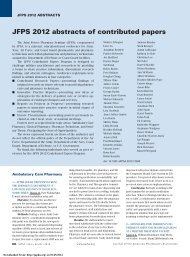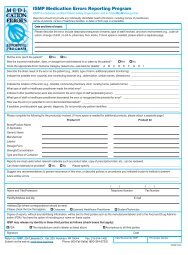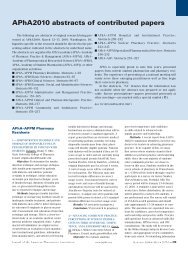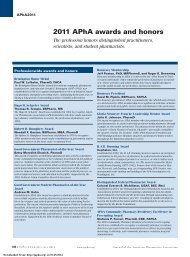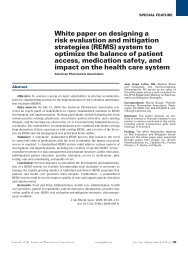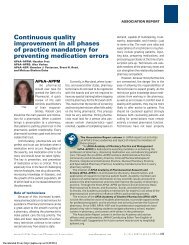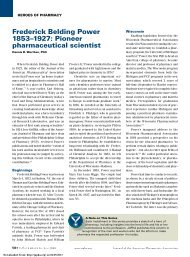Downloaded - Journal of American Pharmacists Association
Downloaded - Journal of American Pharmacists Association
Downloaded - Journal of American Pharmacists Association
Create successful ePaper yourself
Turn your PDF publications into a flip-book with our unique Google optimized e-Paper software.
Annual Meeting Abstracts 2004<br />
FEATURE<br />
chronic pain patients by establishing a collaborative<br />
project via pharmacy and primary care providers.<br />
Methods: The Kaiser Permanente Cascade Park<br />
clinic is one <strong>of</strong> 22 ambulatory care locations in the<br />
Pacific Northwest Region. In the past years,<br />
improvements were needed to provide a more<br />
methodical approach to serve chronic pain patients<br />
who required therapy with controlled substances.<br />
The collaborative project created set out to decrease<br />
workload <strong>of</strong> providers and increase patient satisfaction.<br />
The new system operates on patient lists. One<br />
week before medications are due, a pharmacist sends<br />
a message to the provider stating the following: date<br />
medication is due, the last fill <strong>of</strong> the medication, the<br />
quantity that the prescription was filled for, last<br />
patient appointment, and any special requests or concerns.<br />
An order for the patient’s medication is also<br />
created. Once the provider receives the message, the<br />
order can be approved if continued therapy is intended,<br />
and a signed prescription is sent back to the pharmacy.<br />
Pharmacy staff then files the prescription for<br />
the date that the patient is due for medication and<br />
then on date in question, the prescription is processed<br />
by pharmacy staff.<br />
Results: All clinic providers who care for chronic<br />
pain patients on controlled substances have been<br />
participating in this project, and more than 250<br />
patients have been enrolled.<br />
Conclusions: Since this project began, provider,<br />
patient, and pharmacy satisfaction with the method<br />
<strong>of</strong> processing controlled substances for chronic pain<br />
patients has been overwhelming. A need for change<br />
was identified and satisfied with a technological<br />
update on method <strong>of</strong> service.<br />
92—STUDYING THE PROFESSIONAL<br />
INTERRELATIONSHIP BETWEEN COMMU-<br />
NITY PHARMACISTS AND PHARMACY<br />
TECHNICIANS. Akiyode O, Bullard W, Karodeh<br />
Y, Cao T, Howard University. E-mail: oakiyode@<br />
howard.edu<br />
Objective: To understand the pr<strong>of</strong>essional relationship<br />
between pharmacists and pharmacy technicians.<br />
To identify the supporting and inhibiting factors<br />
toward the pr<strong>of</strong>essional behaviors demonstrated<br />
by the two entities.<br />
Methods: Community pharmacists and pharmacy<br />
technicians will complete a survey tool that<br />
assesses their interaction with each other. The survey<br />
tool is designed to evaluate the attitudes, behaviors,<br />
perceptions, and expectations among the aforementioned<br />
entities. A total <strong>of</strong> 50 surveys will be randomly<br />
distributed to local community pharmacies.<br />
<strong>Pharmacists</strong> will receive one half <strong>of</strong> the surveys,<br />
while pharmacy technicians will receive the other<br />
half. Upon completion <strong>of</strong> the surveys, a pair <strong>of</strong> fivemember<br />
focus groups (one involving pharmacists,<br />
the other technicians) will convene to discuss the<br />
survey results and ways to improve the pr<strong>of</strong>essional<br />
relationship. The participants <strong>of</strong> the focus group discussions<br />
will be randomly selected from the pool <strong>of</strong><br />
the study participants. Upon completion <strong>of</strong> the focus<br />
group discussions, all participants will be asked to<br />
complete a postdiscussion questionnaire to assess<br />
what they have learned from the discussion session,<br />
and how they plan to improve their own pr<strong>of</strong>essional<br />
relationships.<br />
Results: The outcome <strong>of</strong> the surveys, focus<br />
group discussions, and postdiscussion questionnaires<br />
will be analyzed using descriptive statistics.<br />
The study is expected to educate participants and<br />
generate ideas to improve further the relationship<br />
between pharmacists and technicians, hopefully<br />
improving the efficiency <strong>of</strong> the pharmacy and overall<br />
patient care.<br />
Conclusions: NA<br />
93—SURVEY OF PHARMACISTS DESIRE<br />
AND READINESS FOR DISEASE STATE<br />
MANAGEMENT IN OHIO. Dorsch M, Riverside<br />
Methodist Hospital, Kier K, Mraz S, Ohio Northern<br />
University. E-mail: MDORSCH@OhioHealth.com<br />
Objective: Prescription drugs remained the<br />
fastest growing health expenditure, increasing by<br />
15.7%. The state <strong>of</strong> Ohio follows a similar trend.<br />
Currently medications account for 15.1% <strong>of</strong> the<br />
Ohio Medicaid budget, while physician billing only<br />
comprises 6%. Due to the increasing cost <strong>of</strong> health<br />
care and medications, the Ohio <strong>Pharmacists</strong><br />
<strong>Association</strong> (OPA) started discussions with the state<br />
about the concept <strong>of</strong> disease state management<br />
(DSM). The objective was to determine pharmacists<br />
desire and readiness to start DSM programs within<br />
the state.<br />
Methods: OPA put together a task force to discuss<br />
issues relevant to starting a statewide program<br />
in DSM. Based on task force discussions, a survey<br />
was designed and pilot tested to look at DSM issues.<br />
The survey was sent to a random selection <strong>of</strong><br />
licensed pharmacists within the state <strong>of</strong> Ohio. The<br />
survey asked questions relating to demographics,<br />
current practice settings, current DSM practices, and<br />
preparation and desire to provide DSM services.<br />
Descriptive statistics will be used to analyze the data.<br />
Results: Initial results from the survey provided<br />
interesting feedback, especially in the area <strong>of</strong> pharmacist<br />
training and preparation for DSM. In general,<br />
pharmacists were most comfortable with the area<br />
<strong>of</strong> diabetes management. Most pharmacists indicated<br />
a willingness to take more training or certification<br />
in areas <strong>of</strong> DSM. Data analysis is ongoing.<br />
Conclusions: The results will be used by the task<br />
force to make decisions relating to pharmacist interest,<br />
training, and potentially areas for reimbursement.<br />
94—THE DEVELOPMENT OF A PAIN<br />
SERVICE BY THE PHARMACY DEPART-<br />
MENT IN A UNIVERSITY MEDICAL CLIN-<br />
IC. Jacobson S, Massachusetts College <strong>of</strong><br />
Pharmacy and Health Sciences, Debay G,<br />
Massachusetts Institute <strong>of</strong> Technology. E-mail:<br />
deba@med.mit.edu<br />
Objective: To provide pain management education<br />
and reference information to health care<br />
providers and patients in an outpatient ambulatory<br />
clinic and inpatient unit.<br />
Methods: A pharmacist was identified to lead an<br />
educational initiative helping pharmacists, nursing<br />
staff, physicians and other health care providers<br />
learn about effective pain management. All pharmacists<br />
were required to read and successfully complete<br />
posttests associated with journal articles. Case<br />
study discussions were also an integral part <strong>of</strong> their<br />
pain management competency training. Ongoing<br />
education for the pharmacists helped to ensure consistent<br />
communication in their clinical assistance to<br />
the medical staff and in patient counseling. Health<br />
care practitioners were provided pain management<br />
information and guidance on how to identify and<br />
refer patients to the pain service. Assessment tools<br />
such as flow sheets and narcotic conversion charts<br />
were developed by the pharmacy for use in both the<br />
inpatient and outpatient setting. Frequent meetings<br />
with the inpatient and outpatient clinical staff<br />
regarding up-to-date pain management information,<br />
assistance on the proper use <strong>of</strong> pain management<br />
assessment tools, approved formulary medications<br />
for pain, appropriate prescribing, outpatient prescription<br />
and inpatient order writing for medications,<br />
and documentation in the medical chart were<br />
imperative for the success <strong>of</strong> this service. The pharmacy<br />
department is beginning to collect data in both<br />
the inpatient and outpatient records to monitor the<br />
proper use <strong>of</strong> pain assessment tools, appropriate prescribing,<br />
and patient compliance.<br />
Results: The medical and nursing staffs have<br />
reported a positive outcome for patients involved<br />
with the pharmacy pain service. The pharmacists are<br />
finding that providing clinical information to health<br />
care providers and counseling patients receiving<br />
pain medications is a rewarding experience.<br />
Conclusions: A pharmacy-centered pain management<br />
program is beneficial to the university<br />
health system.<br />
95—THE PHARMACIST’S ROLE IN PUB-<br />
LIC HEALTH: A SURVEY OF HEALTH<br />
DEPARTMENT OFFICIALS. Cottrell J, Albany<br />
College <strong>of</strong> Pharmacy, Blumenschein K, University<br />
<strong>of</strong> Kentucky, Paavola F, None. E-mail:<br />
cottrelj@acp.edu<br />
Objective: To examine services provided by state<br />
and local health departments, determine areas into<br />
which health departments would like to expand, and<br />
examine the public health <strong>of</strong>ficials’ perceptions <strong>of</strong><br />
partnering with community pharmacists.<br />
Methods: In December 1999, 25 state health<br />
department Web sites were reviewed to determine<br />
the areas <strong>of</strong> focus that public health agents were<br />
attempting to address. From this assessment, a<br />
three-page survey was developed and sent to directors<br />
<strong>of</strong> 300 health departments, randomly selected<br />
from the National <strong>Association</strong> <strong>of</strong> County and City<br />
Health Officials (NACCHO) mailing list. Each<br />
packet contained a cover letter, a survey, and a selfaddressed<br />
stamped envelope. Surveys were<br />
approved under expedited review by the University<br />
<strong>of</strong> Kentucky Medical Institutional Review Board<br />
and contained 13 questions: 4 addressing staff composition<br />
and responsibilities, 4 addressing current<br />
and future programs, and 5 concerning perceptions<br />
<strong>of</strong> partnering with pharmacists and pharmacy ser-<br />
2004 Abstracts <strong>of</strong> Contributed Papers<br />
Vol. 44, No. 2 March/April 2004 www.japha.org <strong>Journal</strong> <strong>of</strong> the <strong>American</strong> <strong>Pharmacists</strong> <strong>Association</strong> 249<br />
<strong>Downloaded</strong> From: http://japha.org/ on 01/25/2014



